Ready for a taste of Hawaii closer to home? Try this refreshing Poke Bowl recipe—my creative spin on the Hawaiian classic. I season the freshest tuna sashimi with Japanese flavors and serve it donburi style over rice. Customize your bowl with your favorite toppings! It’s a light and satisfying meal for the family or your next DIY Poke Party.
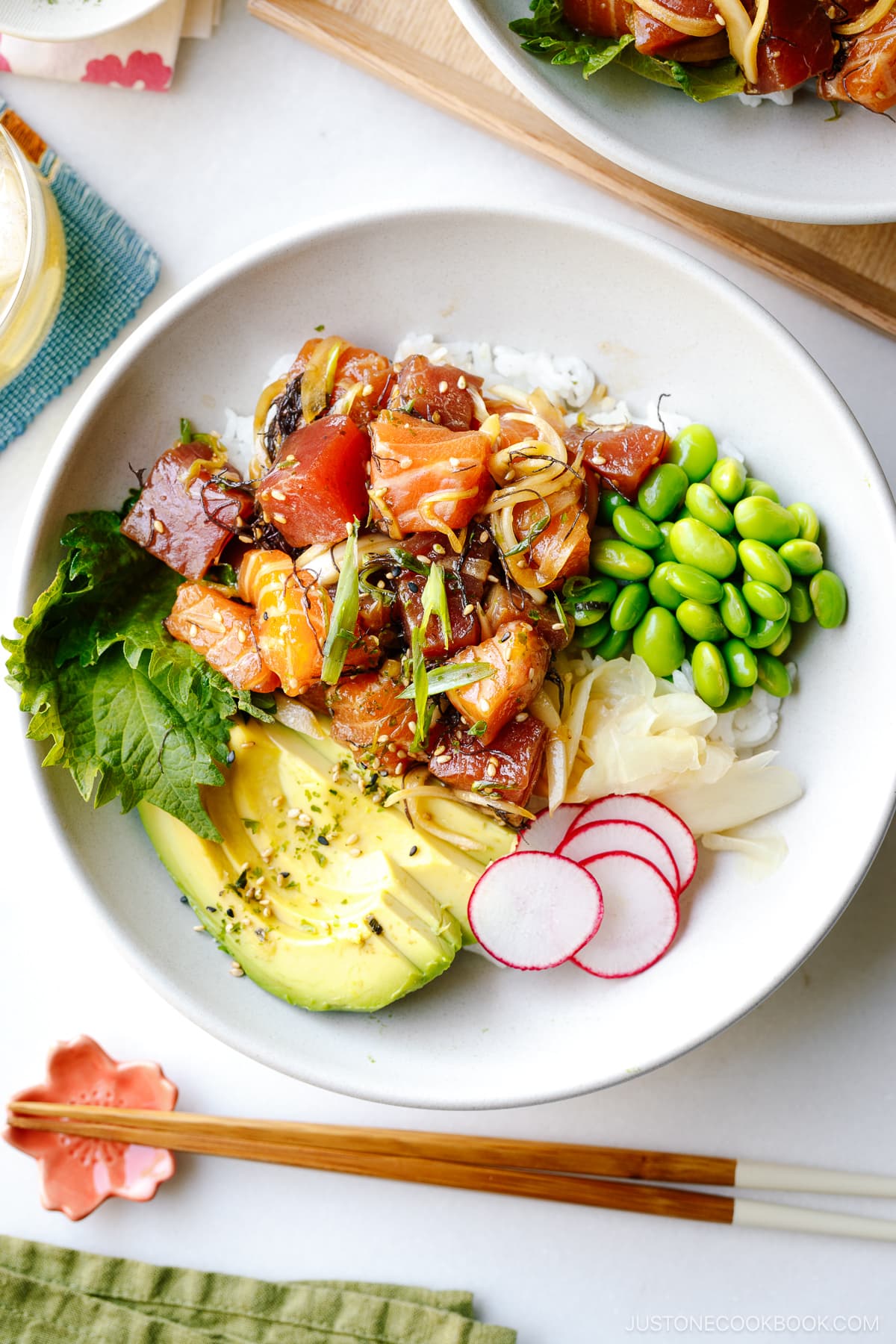
Fresh buttery tuna and salmon tossed with a sesame soy dressing and finished with all the best toppings, this poke bowl is every bite sunshiny, refreshing, and satisfying.
When this beloved Hawaiian favorite first swept up in a craze across the nation, everyone around me cannot stop raving about it. While poke is (technically) no longer a trendy food, its popularity holds strong and found itself a fixture in the food scene outside of Hawaii. There are food trucks, cafes, and fancy restaurants offering all versions of poke bowls. You no longer have to fly to Hawaii to eat poke.
The best part of the news is that poke is incredibly easy to make at home, so long you have access to fresh quality sushi-grade seafood. If you’re ready to bring an authentic taste of Hawaii closer to home, this Tuna and Salmon Poke Bowl recipe is for you!
Table of Contents
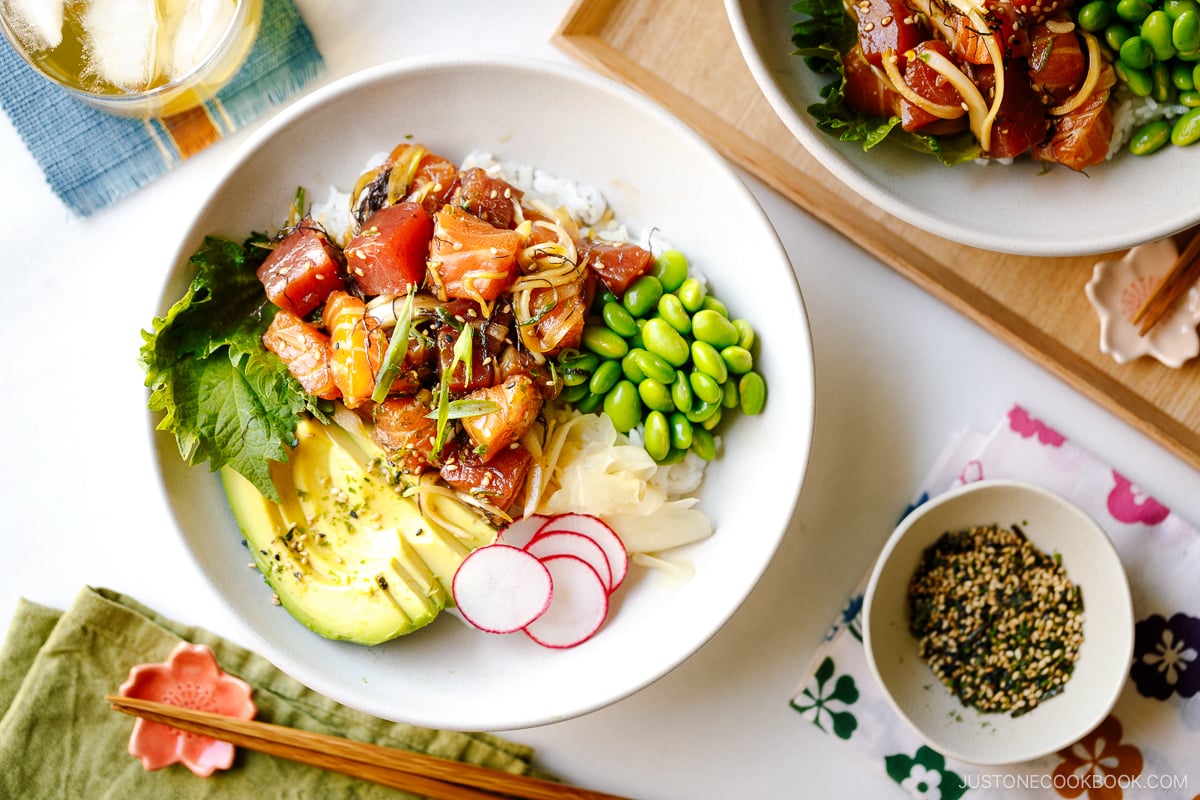
What is Poke?
Originated in Hawaii, poké (pronounced POH-Keh, not POH-Kee) is a dish consisting of marinated diced raw fish served as an appetizer or a main course. In the Hawaiian language, poke can mean anything chunked as it comes from the verb “to section, to slice, or to cut.” Popular seafood used for poke includes ahi (yellowfin tuna), he’e (octopus, tako) and aku (skipjack tuna, katsuo), and salmon.
With heavy influences from Japanese and other Asian cuisines, poke represents the diverse and multifaceted culture of Hawaii. The raw fish is commonly marinated in seasonings such as soy sauce, sesame oil, and green onions, and topped with local condiments such as candlenut, Maui onion, and Hawaiian sea salt.
Now that poke is being spread all over the country, the dish is taking on another whole new level of interpretation. You’ll see ingredients such as mango, cilantro, pickled jalapeño, jicama, and so on being added to the bowl. You can say modern poke has become very much like a seafood salad bowl, bursting with colors, textures, and tastes.
Whether you prefer a classic Hawaiian poke or a modern version, I believe poke is here to stay.

Why Make Poke Bowl at Home
- The best no-cook meal, especially in the summer!
- Endlessly customizable. Make it with just a few ingredients or go crazy with colorful veggies—your call!
- DIY Poke Bowl Party. Super easy and quick to prepare for a large crowd.

How to Cook Poke Bowl
The Ingredients You’ll Need
- Sashimi-grade fish. I used a mix of ahi tuna and salmon.
- The seasonings. For the most basic components of the dressing, you just need shoyu (Japanese soy sauce) and sesame oil. My family loves rice vinegar in the sauce, so I always dash in a few splashes for a refreshing tang. You can also mix in ponzu sauce, sriracha, spicy mayo, gochujang, wasabi, grated ginger juice, lemon and lime juice. Feel free to experiment and find your favorite.
- The veggies. Traditional poke is rather simple and only uses Maui onions, but you can use other varieties of sweet onions that are suited for eating raw. On the other hand, modern poke bowls often include colorful mixes of veggies such as edamame, sprouts, radishes, chopped romaine, leafy greens, etc. (See topping ideas below.)
- The grain (optional). In Hawaii, poke is usually served as an appetizer like a salad, but you can make it into a wholesome one-dish meal by serving poke on top of steamed white rice or brown rice, like the Japanese rice bowl donburi. If you prefer a lighter version, you could also serve poke over quinoa or cauliflower rice for a keto-friendly meal. The possibilities are endless!
The Preparation
- Cut the sushi-grade fish and prepare the toppings of your choice.
- Make the poke seasoning and coat it with the tuna and salmon. Cover and let them marinate in the fridge for at least an hour.
- Serve the tuna and salmon over the steamed rice and add your favorite toppings!
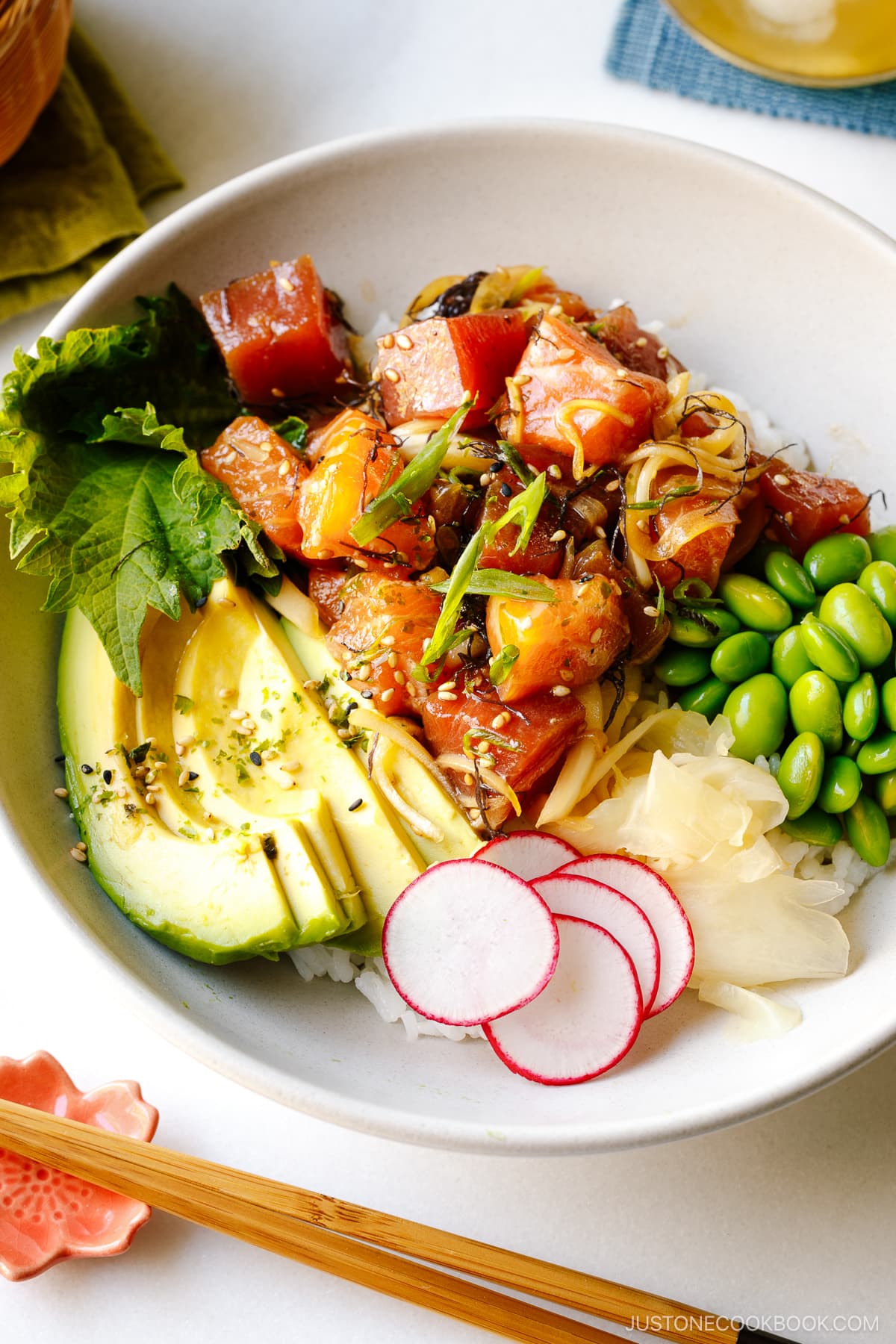
Where to Get Sashimi-Grade Tuna and Salmon
If you live near a Japanese grocery store, I recommend checking out their sashimi selections. I always buy sashimi at Suruki Market in San Mateo. Other Japanese grocery stores that sell sashimi include Nijiya Market, Marukai (Tokyo Central), and Mitsuwa Market Place.
Don’t live near a Japanese grocery store? You can also find sashimi-grade tuna at Whole Foods and local specialty seafood shops. If you are unsure, ask the fishmonger for recommendations.
Another best option is to shop at online sashimi stores such as Catalina Offshore.
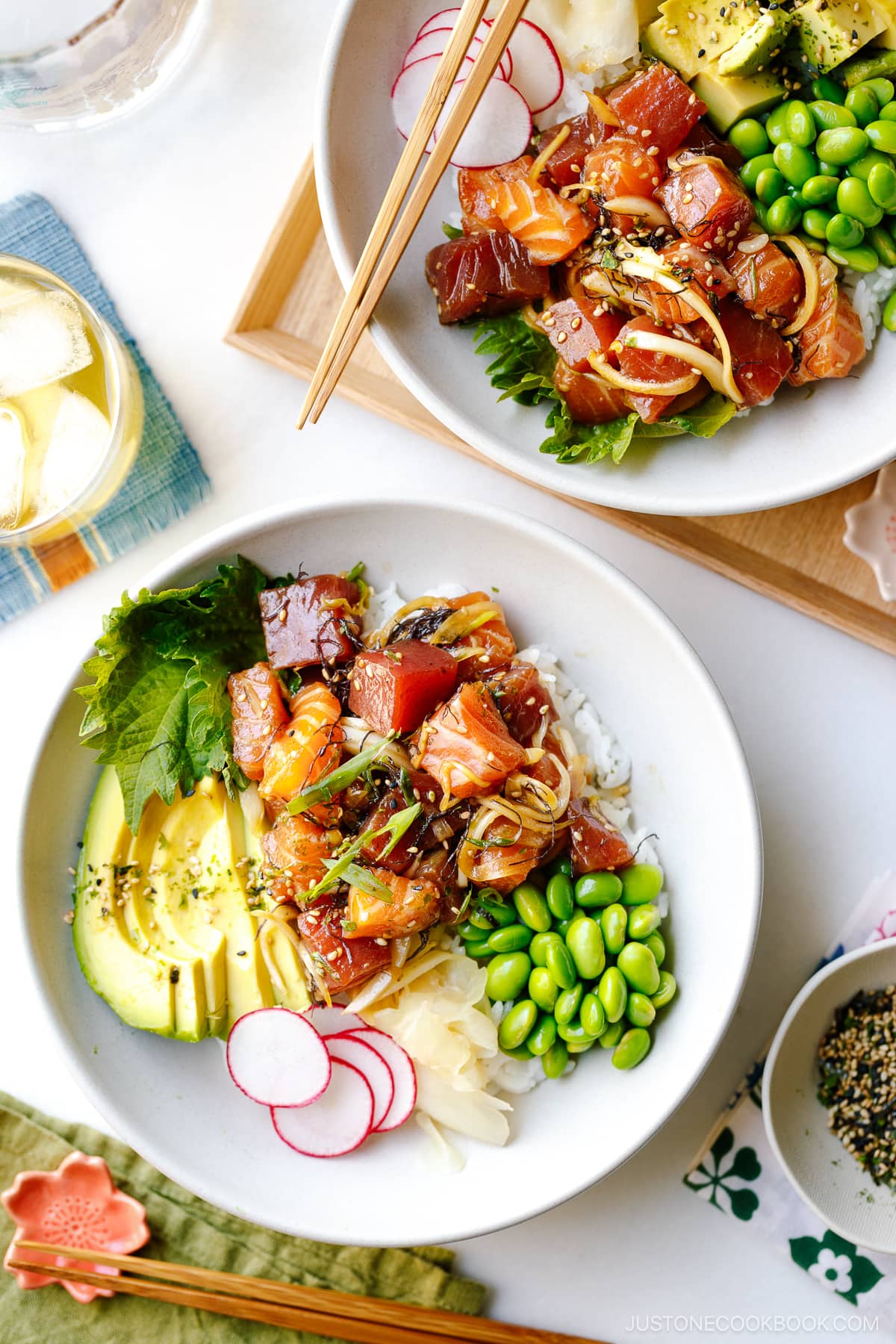
Poke Bowl Variations and Ideas
The concept of a poke bowl opens up plenty of possibilities. To build an incredible bowl, you’d like to keep these in mind—textures, freshness, colors, and balance. Below are some topping ideas for you to work with:
- Avocado – The richness of avocado resembles fatty tuna and adds a creamy texture.
- Veggies such as cucumbers, radishes, and carrots – Depending on what you use, you can thinly slice or dice the veggies into fun shapes to add colors and a refreshing crunch.
- Edamame – Adds a nice substance to the dish and it’s an excellent source of protein.
- Microgreens such as daikon sprouts, broccoli, and kale sprouts. They are pretty and packed with a nutritional punch.
- Green onions – Add a fresh, herby note to the dish.
- Masago – These salty, delicate fish roes add a pop of color and interesting bite.
- Seaweed – Hawaiian ogo seaweed adds authentic texture and flavors. I use the dried ogo seaweed from this poke mix.
- Nori seaweed – Shredded nori or julienned seaweed provides a crispy texture to the poke bowl.
- Sesame seeds – They add an aromatic nutty flavor to the bowl and beautify the dish.
- Macadamia nuts – Or grated kukui nut (candlenut), if you can find this Hawaiian ingredient.
- Furikake (rice seasonings) – Adds another element of fun and umami.
- Pickled sushi ginger (recipe) – Refreshing and zesty.
- Wasabi – So good with fresh sashimi.
- Spicy Mayo – You’ll need only Japanese mayonnaise and sriracha sauce to make this yummy sauce. It will give your poke bowl a creamy, spicy kick!
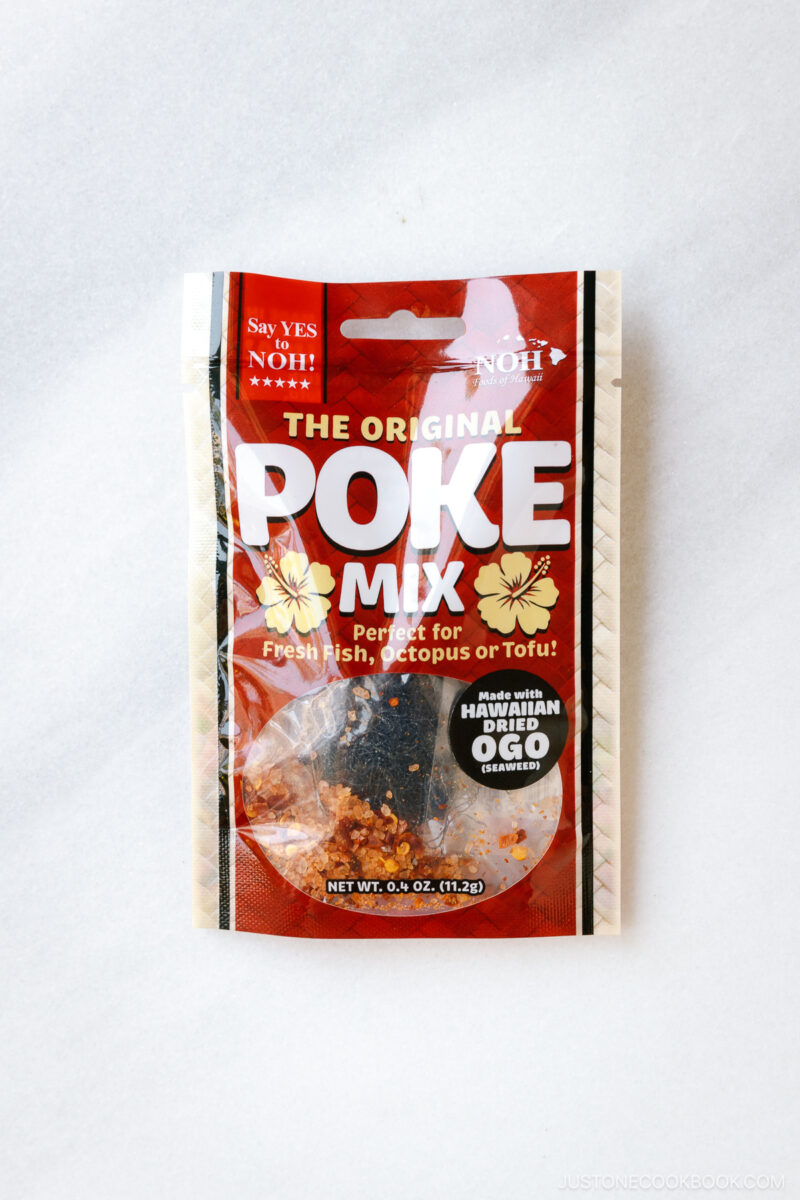
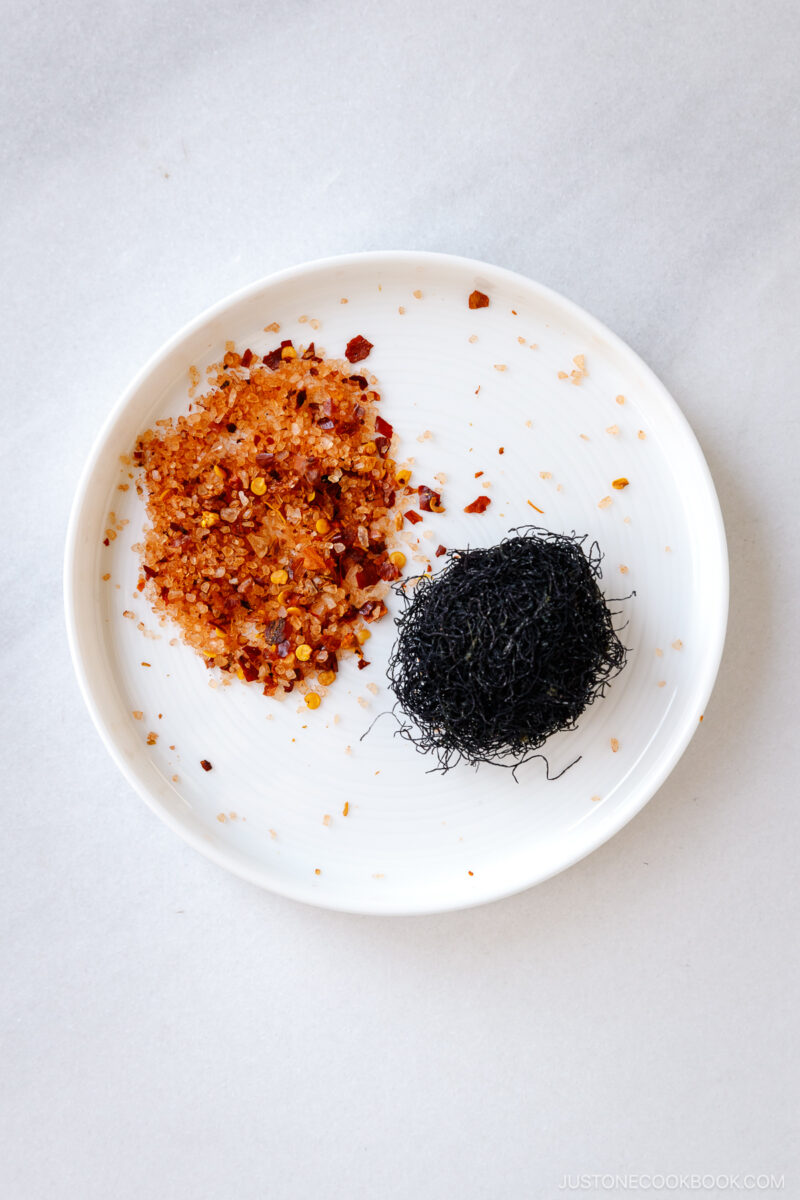
Vegetarian and Vegan Poke Bowls
You can certainly make a vegetarian/vegan version of poke by using tofu. Check out my Vegan Poke Bowl recipe.
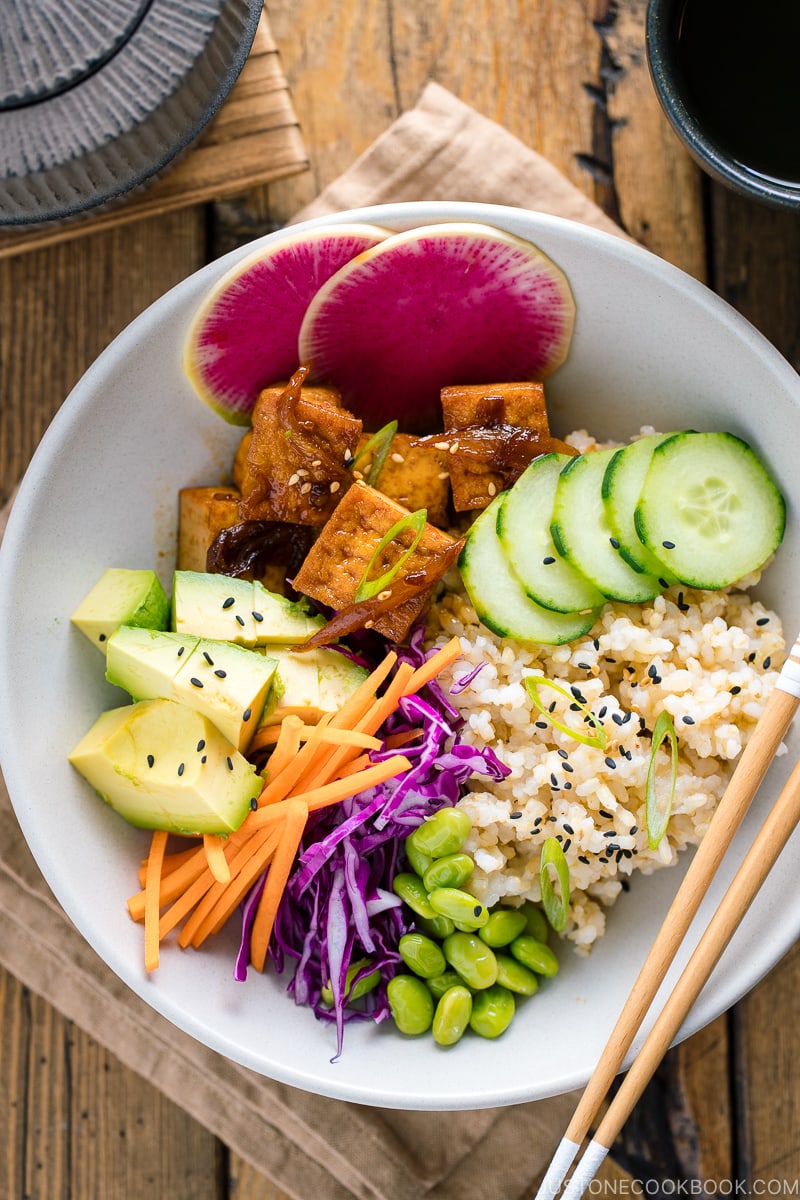
FAQs
Q: Is the poke bowl healthy?
Fresh seafood such as tuna and salmon are considered one of the healthiest foods rich in Omega 3 fatty acids. Combined with colorful vegetables, a poke bowl has a balance of protein, vitamins, and minerals. The sesame oil used in the seasoning is known to improve your appetite (at least we say so in Japan). Be sure to use quality sashimi-grade fish.
However, the definition of ‘healthy’ is subjective and it often comes down to bio-individuality, so use your own discretion or consult with professional nutritionists if you have any health concerns.
Q: How do I make sure the raw fish in a poke is safe to eat?
For people who are new to making raw fish at home, this is a legitimate concern. To minimize the risk of getting sick from eating raw fish, you want to make sure the fish has been handled and frozen properly for sashimi use. Other considerations include spoilage, parasites, and cross-contamination. In most countries, including the US, there’s no regulation around the labels of “sashimi-grade” and “sushi-grade”, so use your own judgment when it comes to buying raw fish.
My family eats raw fish for sashimi and sushi regularly and we don’t have any issues with getting sick. My advice is to get your raw fish from a reputable shop or fishmonger. Since you know the source of the fish itself, it is actually safer to enjoy sashimi at home.
You can learn more about raw fish safety from this article.
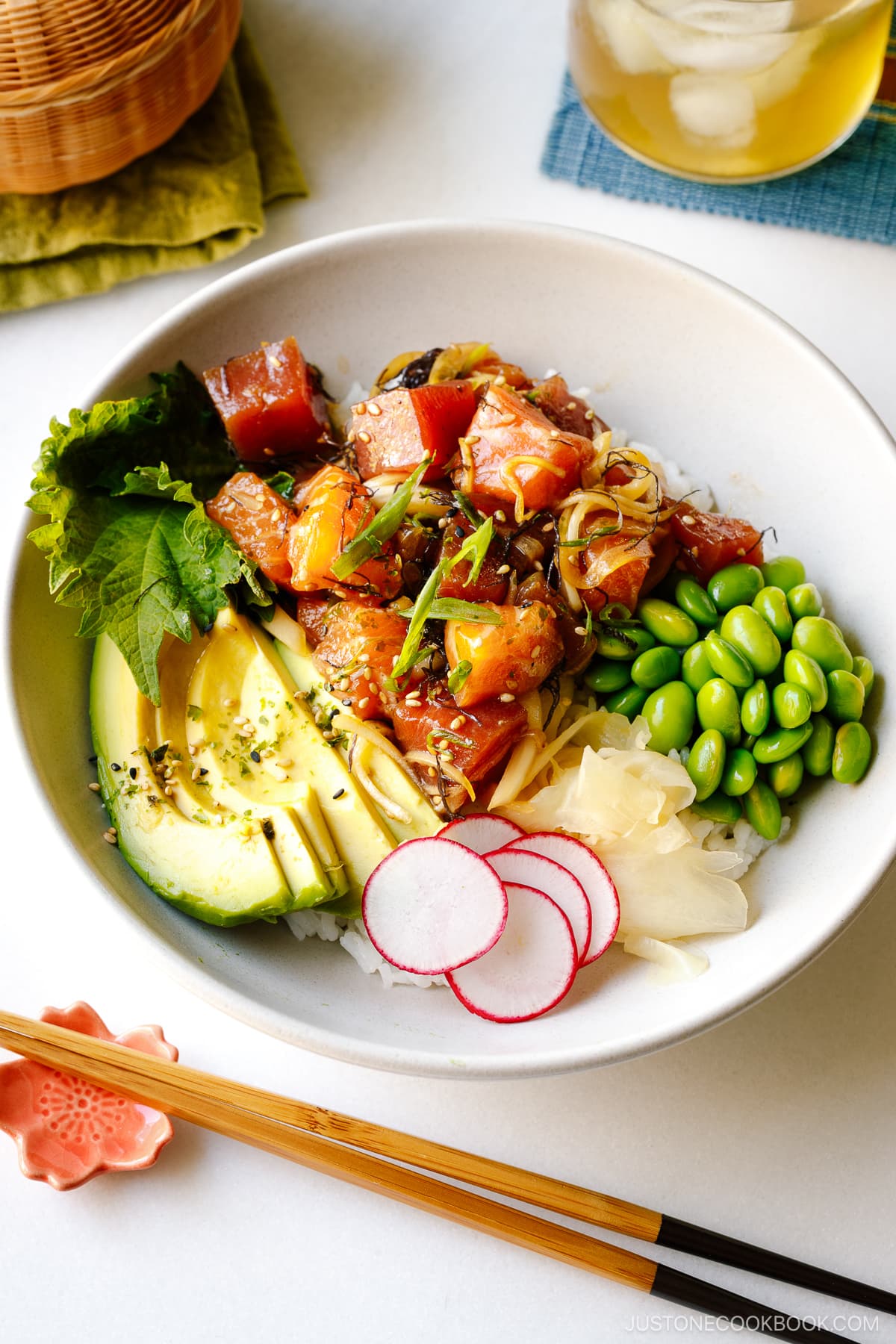
Gluten-Free Soy Sauce for Poke Bowl
For this recipe, I used Kikkoman gluten-free soy sauce (shown on the left in the picture above) in my dressing for the poke. It tastes just like regular soy sauce! Click here to learn more about the product.
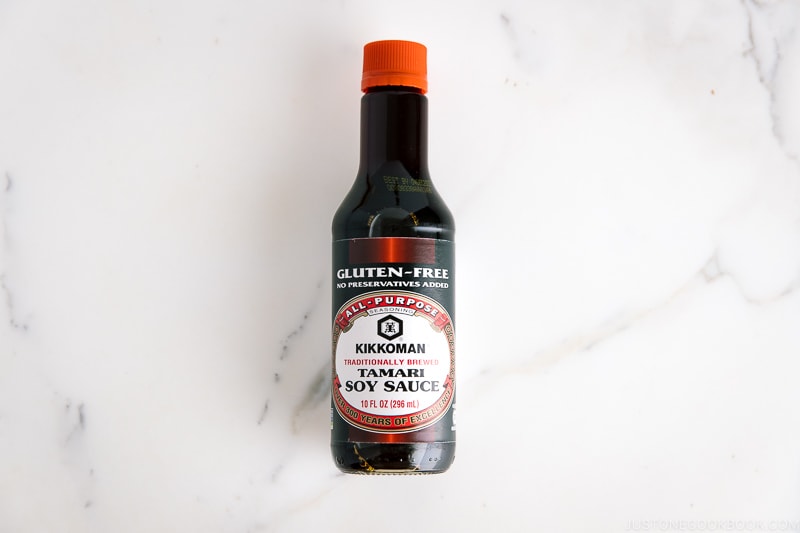
If you’re not gluten intolerant, you can use regular Japanese soy sauce. Please use only Japanese soy sauce as it tastes different from Chinese and Korean soy sauces. Read more here.
More Sushi and Sashimi Recipes You’ll Enjoy
- Salmon Sashimi Bowl
- Spicy Tuna
- Spicy Tuna Rolls
- Temaki Sushi (Hand Roll)
- Miso-Marinated Hamachi Bowl
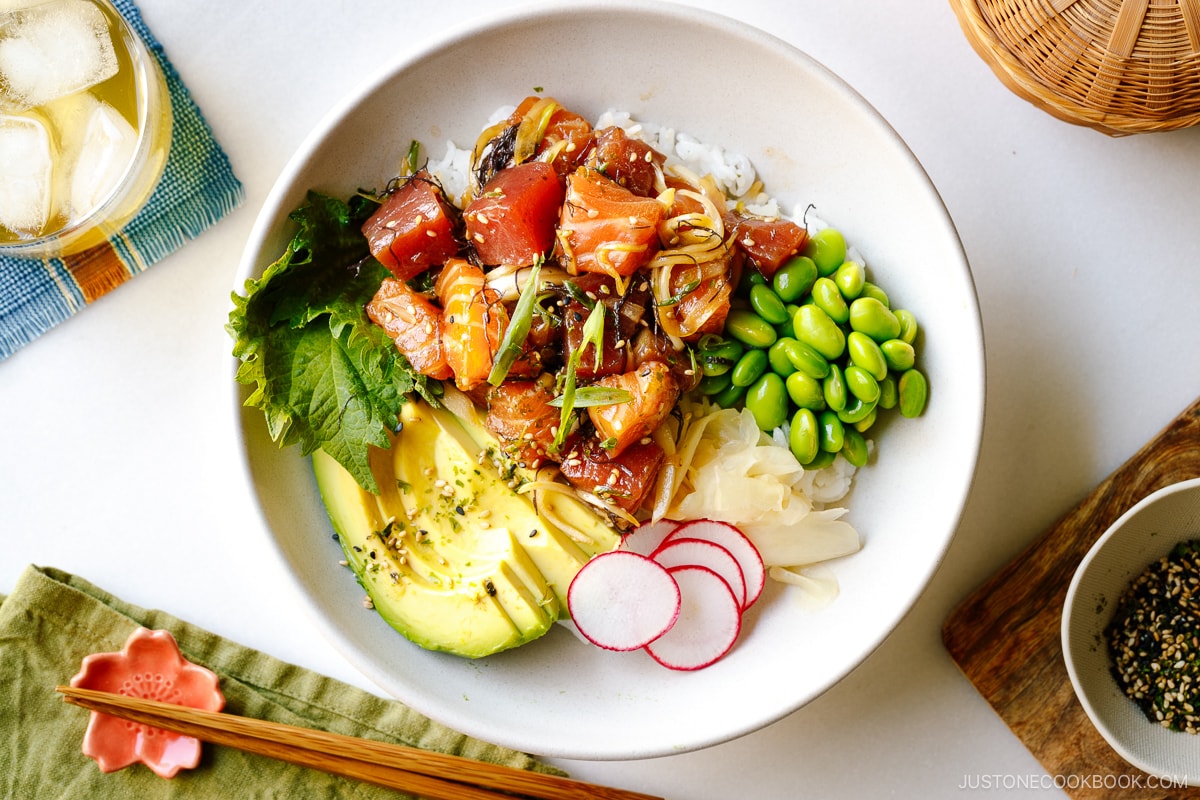
Wish to learn more about Japanese cooking? Sign up for our free newsletter to receive cooking tips & recipe updates! And stay in touch with me on Facebook, Pinterest, YouTube, and Instagram.
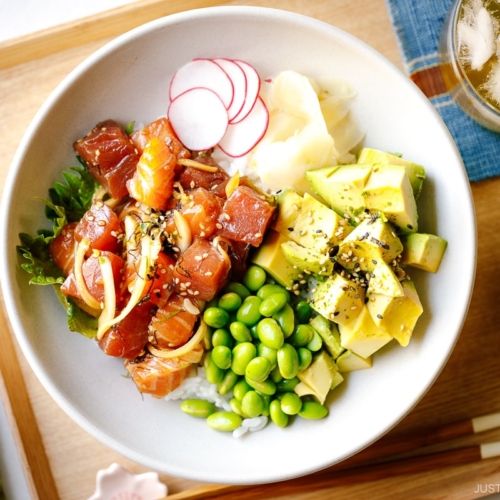
Poke Bowl
Ingredients
For the Poke
- 1 small clump Hawaiian ogo seaweed (dried; about the size of 1 ping pong ball; for 4 servings, I used half the ogo from a Noh Foods Hawaiian Poke Mix package; skip if you cannot find it)
- ½ lb sashimi-grade tuna (try ahi or skipjack for an authentic flavor)
- ½ lb sashimi-grade salmon (though not traditional in poke, salmon brings a nice color to this dish)
- 1 green onion/scallion
- ¼ sweet onion (use Maui onion for the best flavor)
For the Seasonings
- 3 Tbsp soy sauce (GF soy sauce for gluten-free)
- 1 Tbsp toasted sesame oil
- 2 tsp rice vinegar (unseasoned)
- ⅛ tsp Diamond Crystal kosher salt (for a more authentic flavor, try Hawaiian sea salt to taste; used from the same poke mix above)
- ½ Tbsp toasted white sesame seeds
For the Donburi Bowl
For the Creative Toppings (optional; see Notes for more ideas)
- avocado (sliced or cubed; see my simple tutorial to learn how to cut an avocado)
- shelled edamame (boiled)
- Japanese or Persian cucumber (cubed or sliced)
- red radish (thinly sliced)
- sushi ginger (gari) (you can make your own Pickled Sushi Ginger)
- shiso leaves (perilla/ooba)
- furikake (rice seasoning) (you can make homemade Furikake)
Instructions
Before You Start…
- Please note that I recommend a marinating time of 1 hour for the poke to develop the best flavor. If you‘re short on time, you can always marinate for less time or serve it without marinating.
- For the steamed rice, I recommend cooking 2¼ cups uncooked Japanese short-grain rice (3 rice cooker cups, 15.9 oz, 450 g). This yields 6⅔ cups (990 g) cooked rice, enough for 3 donburi servings (roughly 1⅔ cups, 250 g each). See how to cook short-grain rice with a rice cooker, pot over the stove, Instant Pot, or donabe. See how to freeze the leftovers in my post How to Store Cooked Rice.

- Now, gather all the ingredients.

To Prepare the Ingredients
- To a small bowl, add 1 small clump Hawaiian ogo seaweed (dried) and enough water to cover. Soak for 5 minutes to rehydrate.

- Squeeze the water out and cut the ogo into smaller pieces, about 1 inch (2.5 cm) long.

- Thinly slice ¼ sweet onion lengthwise.

- Thinly slice 1 green onion/scallion.

- Cut ½ lb sashimi-grade tuna into bite-sized cubes, about ¾ inch (2 cm).

- Cut ½ lb sashimi-grade salmon into bite-sized cubes, about ¾ inch (2 cm).

To Season and Marinate
- Put the tuna and salmon in a large bowl. Then, add the onion, green onion, and ogo.

- To the bowl with the tuna and salmon, add 3 Tbsp soy sauce, 1 Tbsp toasted sesame oil, 2 tsp rice vinegar (unseasoned), and ⅛ tsp Diamond Crystal kosher salt or Hawaiian sea salt.

- Sprinkle in ½ Tbsp toasted white sesame seeds and gently mix it all together. Cover the poke and marinate it in the refrigerator for at least 1 hour (or up to 12 hours in advance) to develop the flavors. During this time, prepare your optional toppings.

To Serve
- Divide 3 servings cooked Japanese short-grain rice into individual large (donburi) bowls or on plates. Let the rice cool down a little bit, for 3–5 minutes (you don‘t want to warm up the raw tuna). Then, pile the poke on top. If you‘d like, you can add creative toppings of your choice now. I enjoy sliced or cubed avocado (see how to cut an avocado), shelled edamame, thinly sliced Japanese or Persian cucumber (I forgot to add!), thinly sliced red radish, sushi ginger (gari), shiso leaves (perilla/ooba), and furikake (rice seasoning). See my Notes below for more topping ideas. Serve immediately and enjoy!

To Store
- It‘s best to enjoy it on the same day. You can keep the poke ingredients in the refrigerator for up to 24 hours. I recommend cooking the rice just before serving.
Notes
- Avocado – the richness of avocado resembles fatty tuna and adds a creamy texture.
- Veggies such as cucumbers, radishes, and carrots – depending on what you use, you can thinly slice or dice the veggies into fun shapes to add color and a refreshing crunch.
- Edamame – adds a nice substance to the dish and it’s an excellent source of protein.
- Microgreens – try daikon sprouts, broccoli, and kale sprouts; they are pretty and packed with a nutritional punch.
- Cherry tomatoes – quartered; ripe tomatoes add a sweet, flavorful, and lightly acidic element.
- Masago – this salty, delicate fish roe adds a pop of color and an interesting bite.
- Seaweed – shredded nori or julienned seaweed provides a crispy texture to the poke bowl.
- Sesame seeds – sprinkle to add an aromatic nutty flavor and beautify the dish.
- Macadamia nuts – mild and creamy; roasted and chopped macadamia nuts are somewhat close in flavor to roasted kukui nuts (candlenuts).
- Furikake (rice seasonings) – adds another element of fun and umami.
- Pickled sushi ginger (recipe) – refreshing and zesty.
- Wasabi – so good with fresh sashimi.
- Spicy Mayo – you’ll need only Japanese mayo and sriracha sauce to make this yummy sauce; it will give your poke bowl a creamy, spicy kick!
Nutrition
Editor’s Note: The post was originally published on May 27, 2016. It’s been republished with more information and new step-by-step and final images on August 31, 2023.
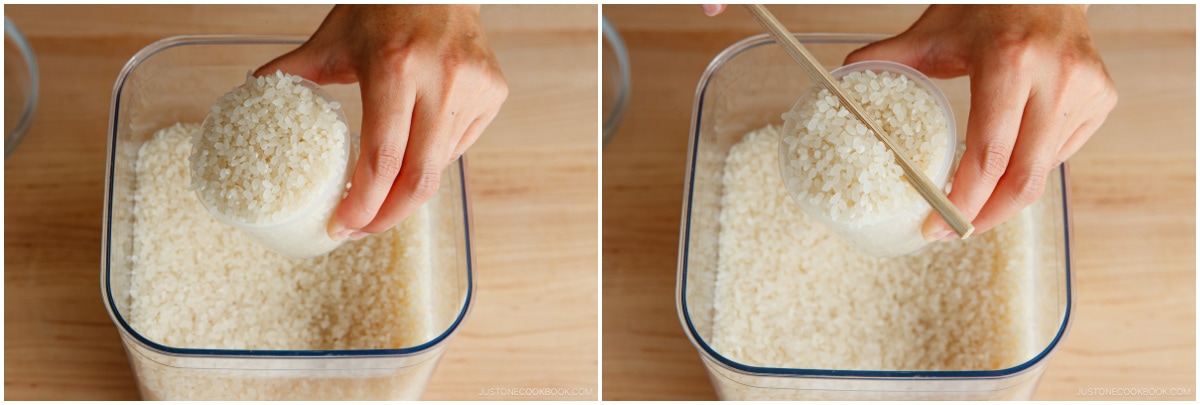

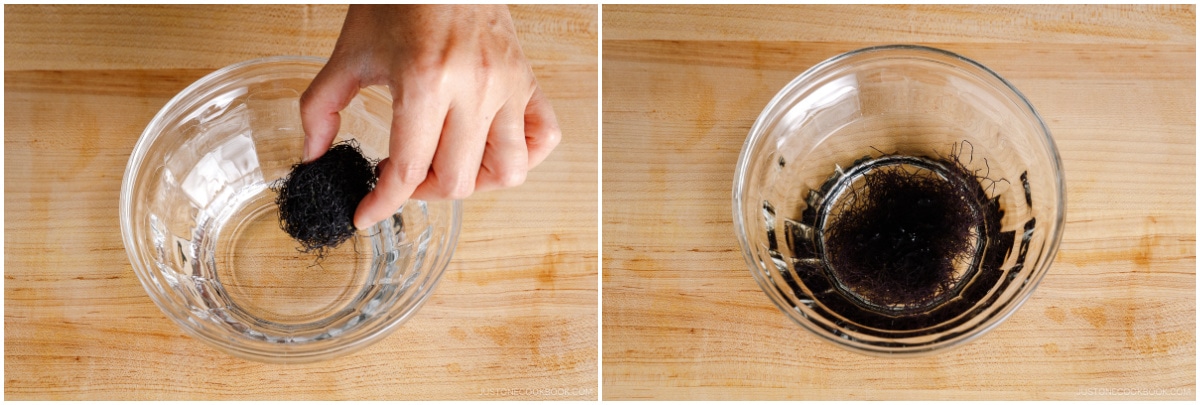
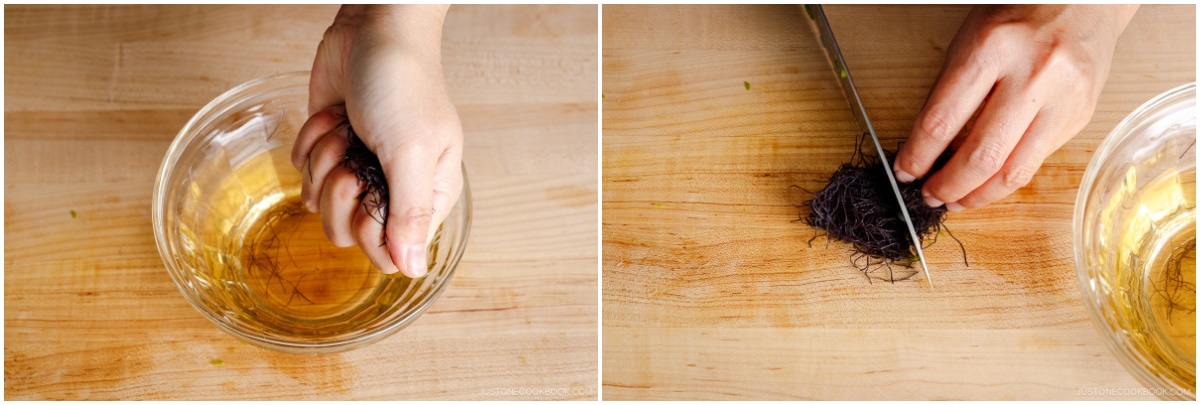
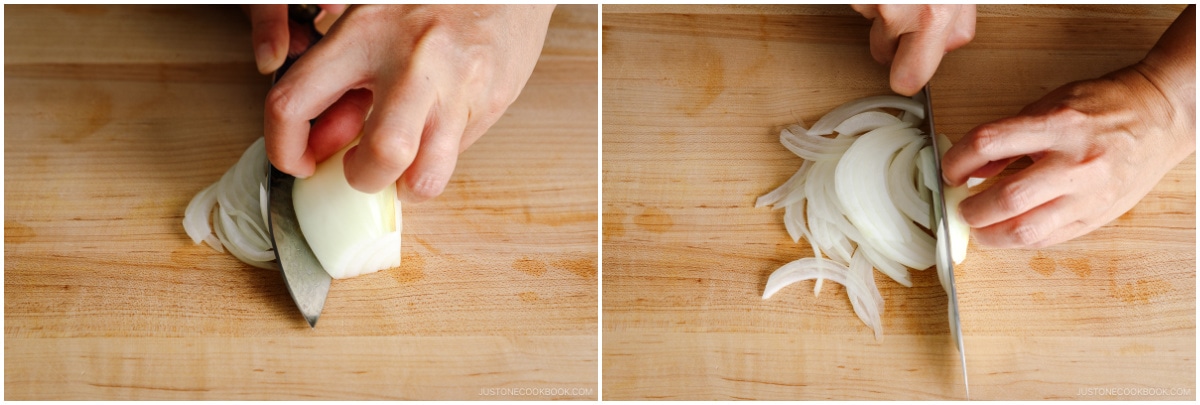
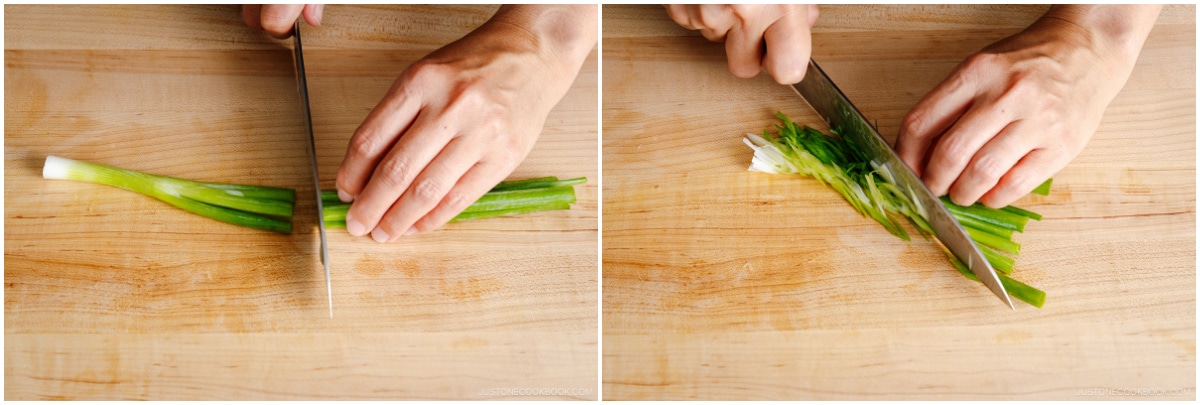

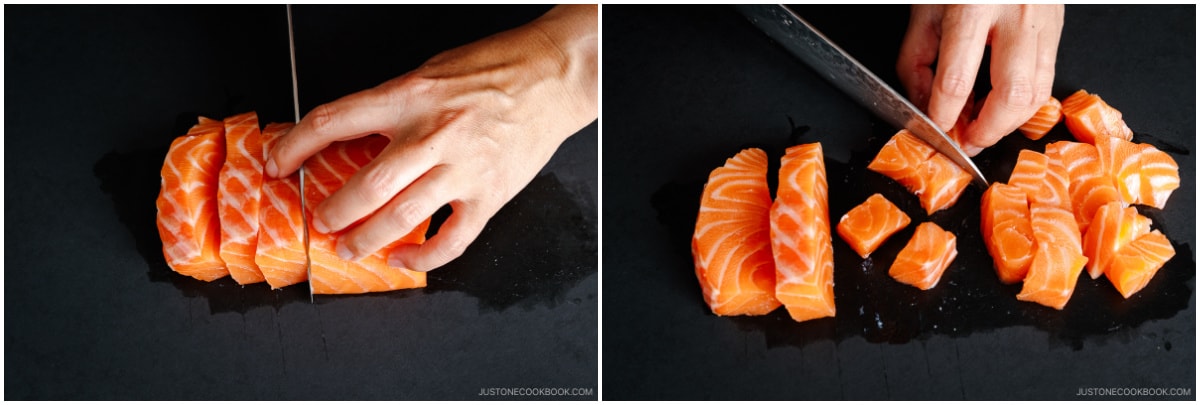
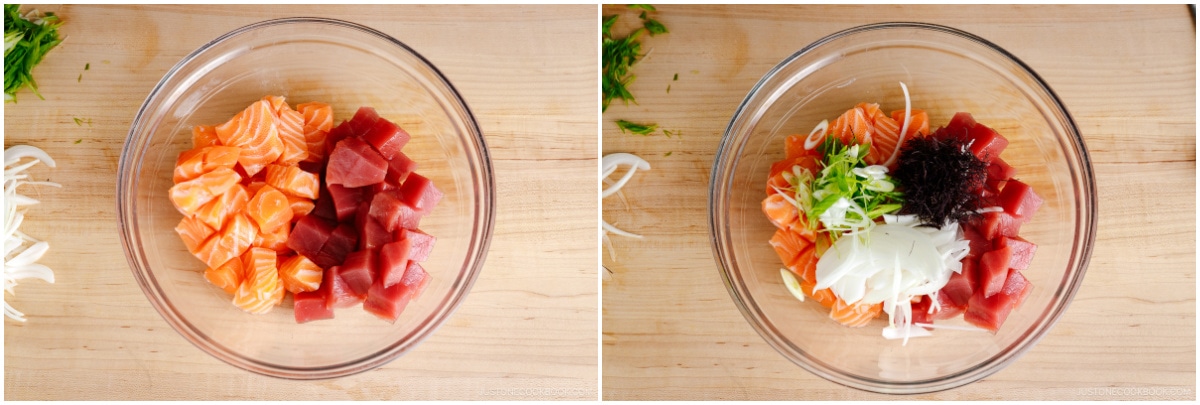
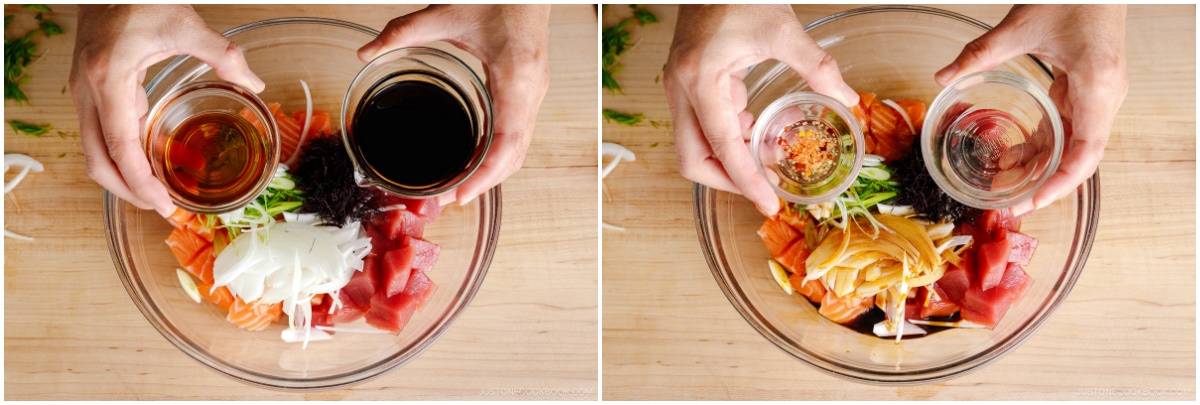
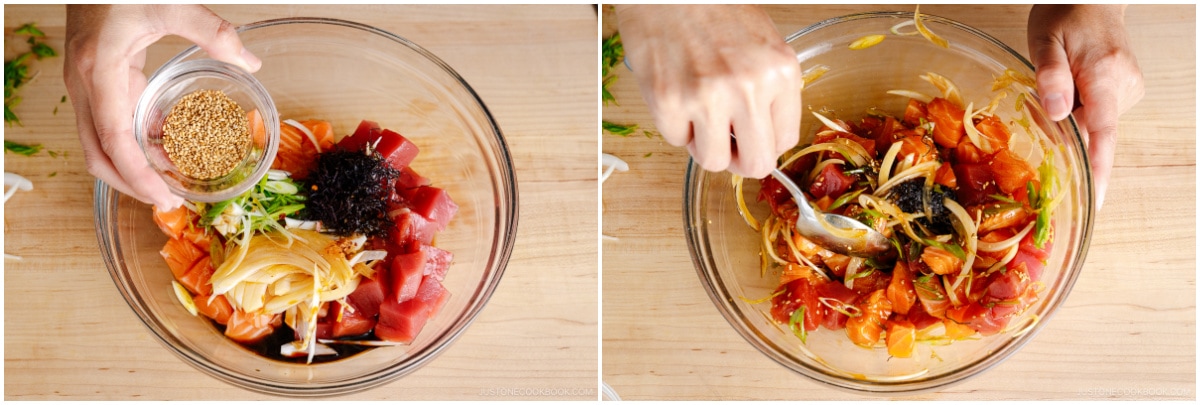
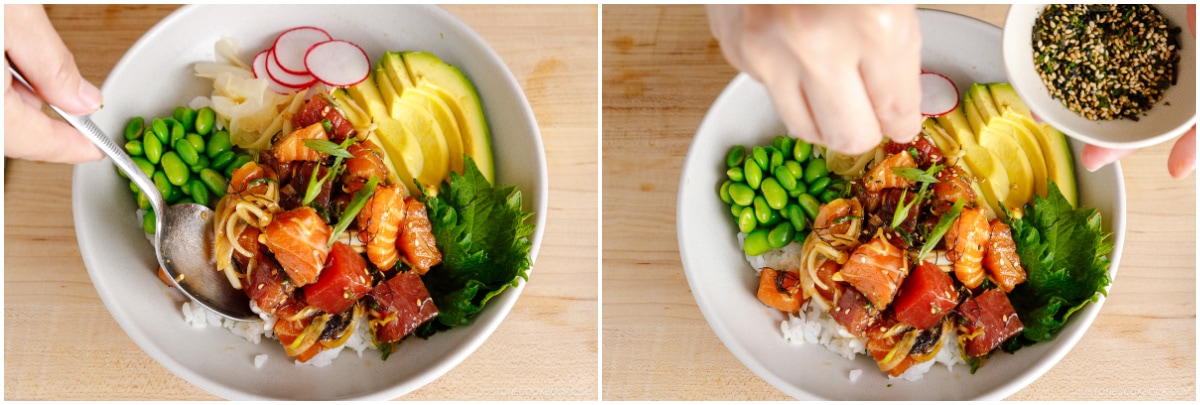











I turned this one into onigirazu too!
Hi James! Wow! Poke Onigirazu! What a fun idea!🙂
Thank you so much for trying Nami’s recipe and sharing idea and photo with us.
Yummy bowl of poke! I loved the combination of flavors and textures. The sauce was just a tad salty for me, but it was fine for my husband.
Hi Linda! Thank you so much! We are glad to hear you enjoy the flavors and textures!
Thank you for trying Nami’s recipe and sharing your photo of Poke Bowl! It looks amazing!
Hi Nami,
Thank you so much for this recipe! This is the first time I’ve made/ eaten a Poke Bowl and I am huge fan now! The flavor combination and textures are something I’ve never tasted before and it was pure deliciousness with each bite! I wasn’t able to obtain the more traditional ingredients of a Poke Bowl so I made more of a California-style Poke bowl with my choice of toppings! I received rave reviews from my family who tried it and will definitely be making this again!
Hi Kyo! Thank you for trying Nami’s recipe and sharing your first-time Poke Bowl photo! It looks awesome!
Nami and the rest of us at JOC are happy to hear you and your family had a great time. Happy Cooking!
I’m always in the mood for poke and this recipe is prepared exactly how I enjoy it most!! Delicious!
Hello, Stephanie! Aww. We’re pleased to hear this recipe came at the right time!
Thank you very much for trying Nami’s recipe and for your kind remarks. Your poke bowl looks fantastic!
Thank you for the lovely recipe! I enjoy how light and refreshing this meal is. Unfortunately tuna is very expensive where I live so I could only use salmon, but it still tasted nice!
Hi Sarah! We are glad to hear you enjoyed Nami’s recipe!
Thank you for trying this recipe and sharing your experience as well as a photo of your poke bowl. It looks amazing!
I LOVE poke bowls!
Hi Marina! Yay!🥰 Thank you so much for trying Nami’s recipe and sharing the poke bowl photo with us!
It looks so delicious!
I could eat poke bowls every day I think! Thanks for the fun challenge!
Hello, Chelle! Aww. We are happy to hear that you enjoyed it so much!
Thank you for taking part in the cooking challenge and sharing the photo of the delicious-looking poke bowl. Happy Cooking!
Love any excuse for a poke bowl
Hi Naomi! Thank you so much for trying Nami’s recipe and sharing your Poke Bowl photo with us!
Happy Cooking!
Love poke bowls and you can add more veggies than rice at home
Hi Linh Cao-Chan! Thank you so much! We are glad to hear you enjoyed Nami’s Poke Bowl recipe!
Thank you for posting your Poke Bowl photo. It looks delicious!